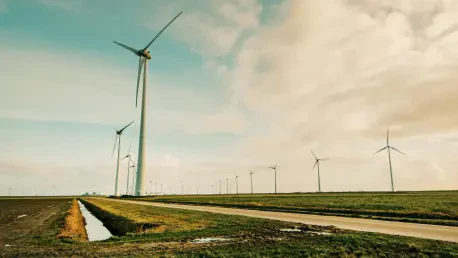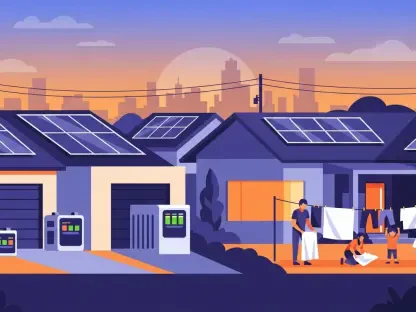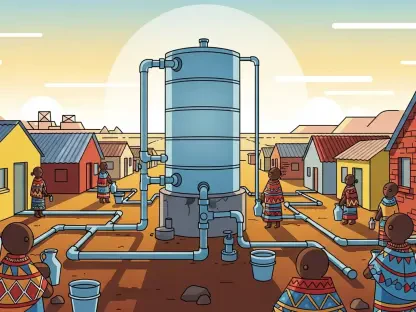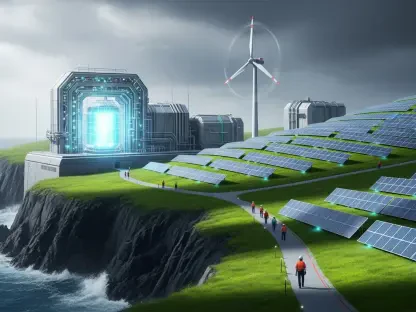Cambodia stands at a critical juncture in its pursuit of sustainable economic progress, with energy efficiency emerging as a linchpin for balancing rapid growth with environmental responsibility. As one of Southeast Asia’s fastest-developing nations, the country has witnessed unprecedented industrial expansion and urbanization, driving energy consumption to staggering levels. Yet, this surge comes at a cost—escalating energy waste threatens economic stability and environmental health. Discussions at Clean Energy Week, held on October 3, brought together experts, policymakers, and industry leaders to underscore the pressing need for energy-efficient practices. With national targets aiming for a 19% reduction in energy use by 2030, as set by the 2022-2030 National Energy Efficiency Policy, the stakes couldn’t be higher. The challenge lies in transforming ambitious goals into actionable outcomes amidst rising demand, projected to hit 38,600 GWh annually by 2030, fueled by sectors like garment manufacturing and emerging industries such as electronics.
Economic and Competitive Advantages of Energy Efficiency
Driving Cost Savings and Investment
Energy efficiency presents a powerful opportunity for Cambodia to curb operational expenses in key industries, particularly those that rely heavily on energy-intensive processes. By minimizing energy waste, businesses stand to save substantial resources, with projections estimating potential savings of up to 10,000 GWh in the industrial sector by 2030. These reductions translate into lower production costs, enabling companies to reinvest savings into innovation or expansion. Moreover, a commitment to efficient energy use enhances Cambodia’s appeal to foreign investors who prioritize sustainable operations. As global markets increasingly value environmental responsibility, demonstrating a dedication to reducing energy consumption can position the country as a prime destination for investment, fostering long-term economic stability and growth in a competitive landscape.
Beyond immediate financial benefits, energy efficiency also serves as a catalyst for job creation and technological advancement within Cambodia. Implementing energy-saving measures often requires the adoption of modern equipment and systems, spurring demand for local expertise in installation and maintenance. This, in turn, can stimulate domestic industries related to energy technologies, creating a ripple effect of economic activity. Additionally, lower energy costs can make Cambodian products more price-competitive on the global stage, particularly in sectors like manufacturing, where margins are often tight. The alignment of cost savings with broader economic goals underscores the transformative potential of energy efficiency, making it a strategic priority for policymakers and business leaders aiming to secure a prosperous future for the nation.
Enhancing Global Competitiveness
In an era where sustainability is a benchmark for global trade, adopting energy-efficient practices is vital for Cambodia to maintain its standing in international markets. Industries such as garment manufacturing, which form the backbone of the economy, face growing pressure from buyers and investors to meet stringent environmental standards. Failure to integrate energy efficiency could result in lost contracts or diminished market share as competitors in neighboring countries adopt greener practices. By prioritizing energy-saving technologies and processes, Cambodian businesses can not only comply with these expectations but also differentiate themselves as leaders in sustainable production, thereby securing a competitive edge.
Furthermore, aligning with global sustainability trends through energy efficiency can open doors to new partnerships and trade opportunities for Cambodia. Many international corporations now seek supply chain partners who demonstrate a commitment to reducing carbon footprints, and Cambodia’s adoption of such measures can attract these lucrative collaborations. This shift also positions the country favorably in negotiations for trade agreements that prioritize environmental criteria. Beyond immediate market benefits, a reputation for sustainability can enhance Cambodia’s global image, drawing attention from environmentally conscious consumers and organizations. Thus, energy efficiency becomes a strategic tool not just for economic survival but for thriving in a world increasingly defined by green priorities.
Sector-Specific Needs and Challenges
Buildings and Industrial Parks
The building sector in Cambodia, accounting for 30-35% of national energy demand and emissions, represents a critical frontier for energy efficiency interventions. High energy consumption in residential and commercial structures, often due to outdated designs and inefficient cooling systems, contributes significantly to both costs and environmental impact. Experts advocate for the adoption of green construction practices, such as improved insulation and energy-efficient lighting, to curb this trend. Implementing these measures not only reduces energy use but also aligns with national sustainability goals, offering a blueprint for urban development that prioritizes long-term ecological balance over short-term gains.
Industrial parks, another major energy consumer, face similar challenges but also hold unique potential for transformative change. Insights from organizations like the United Nations Industrial Development Organization highlight the importance of integrating energy efficiency into these hubs to achieve substantial cost savings and sustainability. Innovative models, such as agro-industrial parks, demonstrate how industries can repurpose waste and optimize resource use, creating a circular economy. However, the transition requires significant investment and coordination among stakeholders to retrofit existing facilities and design new ones with efficiency in mind. Addressing these needs in industrial parks could set a precedent for scalable solutions across other sectors.
Garment Industry Under Pressure
As a cornerstone of Cambodia’s economy, the garment sector is under intense scrutiny to adopt energy-efficient practices amid global demands for cleaner production. This industry, which employs a significant portion of the workforce, faces mounting challenges due to rising energy costs and the need to comply with international climate change imperatives. Implementing energy-saving technologies, such as modern machinery and optimized factory layouts, can drastically reduce operational expenses while meeting these external expectations. Such measures are not merely cost-effective but essential for maintaining relevance in a market where sustainability is increasingly non-negotiable.
The urgency for change in the garment industry also stems from investor demands for transparency and environmental accountability. Factories that fail to adapt risk losing partnerships with major brands that prioritize green supply chains. Beyond financial incentives, adopting energy efficiency in this sector can improve working conditions by reducing heat and energy waste, thereby enhancing worker productivity and well-being. Collaboration between government bodies and private enterprises is crucial to facilitate access to resources and knowledge needed for this transition. By addressing these pressures head-on, the garment industry can secure its position as a vital economic driver while contributing to national energy goals.
Innovative Solutions and Barriers
Financing Through ESCO Models
The Energy Service Company (ESCO) model emerges as a promising solution to fund energy efficiency upgrades in Cambodia, particularly for large energy consumers like factories and commercial buildings. Under this approach, ESCOs provide upfront capital and technical expertise to implement energy-saving technologies, with repayments tied to the resulting cost savings. This innovative financing mechanism alleviates the burden of initial investment for businesses, making efficiency upgrades accessible even to those with limited budgets. However, the model’s effectiveness is constrained by challenges such as insufficient data from factories to assess energy needs accurately, which hampers project planning and execution.
Scaling the ESCO model across Cambodia also faces hurdles related to access to financing and trust in the system. Many businesses remain hesitant to engage due to a lack of awareness about potential benefits or concerns over long-term financial commitments. Addressing these barriers requires robust policy support to incentivize participation, alongside efforts to improve data transparency within industries. Partnerships between government agencies and international development programs can further bolster the model by providing guarantees or subsidies. Overcoming these obstacles is essential to unlock the full potential of ESCOs as a catalyst for widespread energy efficiency adoption in the country.
Building a Skilled Workforce
A significant barrier to implementing energy efficiency initiatives in Cambodia is the shortage of trained professionals capable of designing, managing, and auditing energy systems. Without a skilled workforce, even the most well-funded projects risk underperforming due to improper execution or maintenance. Institutions like the Institute of Technology of Cambodia are stepping up to address this gap by offering specialized training programs for energy managers and auditors. These initiatives aim to build a pipeline of expertise that can support both public and private sector efforts to reduce energy waste, ensuring that technical know-how matches the scale of national ambitions.
Beyond formal education, there is a need for continuous professional development to keep pace with evolving energy technologies and practices. Workshops, certifications, and on-the-job training can equip existing workers with the skills needed to adapt to new systems. International collaboration also plays a role, as partnerships with global organizations can bring in best practices and advanced training methodologies. By prioritizing workforce development, Cambodia can create a sustainable foundation for energy efficiency, ensuring that human capital keeps up with infrastructural and policy advancements. This focus on skill-building is a critical step toward achieving long-term energy goals.
Systemic Obstacles and Collaborative Solutions
Regulatory and Awareness Gaps
Despite the existence of comprehensive national policies aimed at promoting energy efficiency, Cambodia grapples with significant regulatory gaps and inconsistent enforcement that hinder progress. Policies often lack the detailed frameworks needed for practical implementation, leaving businesses and local authorities unclear on how to comply with targets. Additionally, the absence of robust monitoring mechanisms makes it difficult to track advancements or hold stakeholders accountable. Experts stress that bridging these gaps requires not only stronger legislation but also actionable guidelines that translate high-level goals into day-to-day practices across various sectors.
Public awareness, or the lack thereof, further complicates the adoption of energy-efficient behaviors in Cambodia. Many individuals and small businesses remain unaware of the benefits of energy conservation or the specific steps they can take to contribute. Targeted campaigns that educate communities about simple measures—like using energy-efficient appliances or optimizing daily consumption—can drive behavioral change. Coupled with improved data collection to inform policy adjustments, raising awareness is a vital component of overcoming systemic challenges. Addressing these issues head-on can pave the way for more effective energy efficiency strategies.
Multi-Stakeholder Collaboration
Achieving energy efficiency goals in Cambodia demands a coordinated effort across diverse groups, including government bodies, private industries, academic institutions, and international partners. Organizations like Geres are already working alongside policymakers to propose practical solutions tailored to local needs, while academic entities such as the Institute of Technology of Cambodia collaborate with energy consumers to certify professionals. However, these efforts must be scaled through broader partnerships to ensure that policies are not only designed but also implemented with real-world impact. Unified action is essential to address the multifaceted nature of energy challenges.
Collaboration also extends to leveraging international expertise and funding to support Cambodia’s energy transition. Development programs and global institutions can provide technical assistance and financial resources to complement local initiatives. For instance, sharing successful case studies from other nations can inspire innovative approaches suited to Cambodia’s context. By fostering dialogue among all stakeholders, the country can create a cohesive strategy that aligns national targets with on-the-ground realities. This collective approach is the key to turning energy efficiency from a concept into a tangible driver of sustainable growth.
Paving the Path to a Sustainable Future
Reflecting on the insights shared during Clean Energy Week on October 3, it became evident that energy efficiency has solidified its role as a transformative force for Cambodia’s economic and environmental landscape. The discussions illuminated how targeted interventions in sectors like buildings, industrial parks, and garment manufacturing have begun to yield cost savings and competitive gains. Innovative financing through ESCO models has shown early promise in overcoming investment barriers, while training programs have started to build a skilled workforce to sustain these efforts. Looking ahead, the focus must shift to actionable next steps: strengthening regulatory frameworks to ensure policy enforcement, scaling public awareness campaigns to foster a culture of conservation, and deepening multi-stakeholder partnerships to pool resources and expertise. By prioritizing these solutions, Cambodia can bridge the gap between ambitious targets and practical outcomes, securing a future where growth and sustainability coexist harmoniously.









